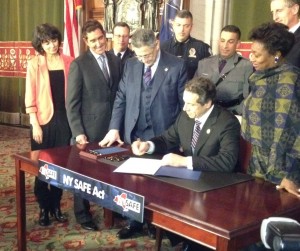Top 10 Adirondack News Stories of 2013
2013 was a hectic, provocative year for the Adirondacks. There were fiery debates among green groups, map-changing conservation efforts, and a new push for common ground among old combatants.
The Park saw new economic energy in communities like Saranac Lake and Schroon Lake, but challenges deepened for more remote areas, including Hamilton County and southern St. Lawrence County.
As we prepare to launch into 2014, here are my ten picks for the stories that are most memorable and have the most enduring impact from the last twelve months.
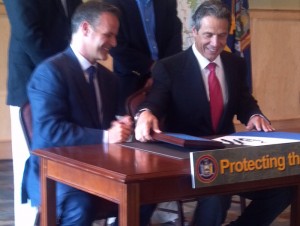
Governor Cuomo (Right) and Bill Ulfelder, executive director of New York’s Nature Conservancy signing the Finch Pruyn deal in August 2012 (Photo: Brian Mann)
1. Finch lands deal approved, creating new Hudson River Gorge Wilderness. The Adirondack Park Agency, working closely with the DEC, the governor’s office, local government leaders, and two of the Park’s largest green groups, crafts a plan that will create a vast new wilderness and primitive area along the upper Hudson River. It’s the biggest new motorless area created in the Adirondacks in a generation. The APA’s vote is unanimous.
2. North Country wins big economic development grants, including
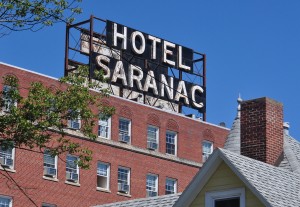
The faded Hotel Saranac was once a centerpiece of the village economy and social life (Photo: Susan Waters)
funding for two Saranac Lake hotels. The project will renovate the historic Hotel Saranac, an icon in the Park and once a destination. More controversial is a plan to build a new resort on the shore of Lake Flower.
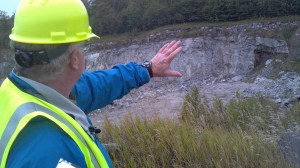
A NYCO official points at forest preserve land that will be mined under a land swap on 2013 ballot (Photo: Brian Mann)
3. Adirondack land swaps approved by NY voters. Two big land swaps, including a controversial project involving NYCO Minerals, are approved by voters on the statewide ballot. The debate sparks a major rift within the Park’s green community, but local government leaders hail the effort as symbolic of a new era of cooperation and dialogue.
4. Adirondack Scenic Railroad debate escalates. A debate over the

NCPR’s coverage of the rail-trail debate comes as New York state is gathering public comments about the future of the rail corridor. (Photo: Brian Mann)
state-owned rail corridor from Old Forge to Lake Placid grew fierce and ugly in 2013. State officials launched an informal listening session to take comments on the rail vs. trail debate, but it’s still unclear whether New York will reopen a full process to re-evaluate future use of the route. At times, the vitriol rose to startling levels, with accusations of dishonesty and class-warfare.
5. Regional effort saves Adirondack movie theaters. The “Go Digital or Go Dark” campaign gained traction in 2013, raising enough funds to allow cinemas across the Park – from Ausable Forks to Tupper Lake — to convert to new digital technology, ending the era of film.
6. Cuomo brings Adirondack Challenge to Indian Lake. Governor Andrew  Cuomo and top state officials joined in a rafting race with New York City Mayor Michael Bloomberg in July. It was political theater of the highest order that generated a huge amount of ink about the Adirondacks.
Cuomo and top state officials joined in a rafting race with New York City Mayor Michael Bloomberg in July. It was political theater of the highest order that generated a huge amount of ink about the Adirondacks.

Is the Newton Falls Paper Mill a good investment for taxpayers? Photo: Newton Falls Paper support group on Facebook
7. Newton Falls paper mill dismantled. There was a long battle to save the Newton Falls paper mill, and many near-misses as various Canadian companies promised to reopen the long-mothballed plant. But in 2013, the equipment was dismantled and sold, ending a long, painful chapter in the Park’s effort to hold onto some of its industrial base. Big questions remain about the future of the economy in southern St. Lawrence County.
8. NY SAFE Act debate heats up. Signed by Governor Andrew Cuomo in January 2013,
the SAFE Act has remained popular in downstate New York. But the gun-control measure has become a lightning rod in more conservative upstate districts, becoming a flash point in political campaigns, with some county sheriffs insisting that they won’t enforce it and many gun owners insisting that they’ll defy the law as an act of civil disobedience.
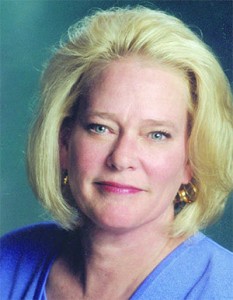
Adirondack Health CEO Chandler Ralph sparked a fierce debate in 2013, arguing that financial losses at the Lake Placid ER were unsustainable. (PHOTO: AMC)
9. Adirondack healthcare industry shake up. The Park’s healthcare system continues to undergo tectonic shifts, as long-time health providers enter into new partnerships and mergers, laying off staff, and considering closure of facilities. A major debate grows over future of the Lake Placid Hospital. Meanwhile, Hudson Headwaters continues to expand clinics and services inside blue line.
10. Israel Keyes serial killer story unfolds. FBI continues to release details about Adirondack
activities of a predator who robbed a bank in Tupper Lake and allegedly buried one of his victims in the Park. Following his suicide in an Alaska jail cell in December 2012, federal agents urge Adirondackers to provide help recreating Keyes’ travel in the region.






